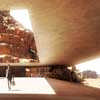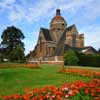Suburbia Building Design, Outer City Properties Opinion, News, Meaning, Progress, Climate Change
Suburban Built Environment
Sustainable Architecture Discussion by Trevor Tucker, Ottawa, Canada
20 Oct 2009
Suburban Design
Suburbia : a place for poets?
They say of Samuel Taylor Coleridge, the Romantic poet and famous opium addict, that he was prone to digress into his illustrations. He had a far-searching mind that just couldn’t leave well enough alone. Defining sustainable community would have given him hours of fun.
Renewable energy. Ten percent of Germany’s roofs now green. Ten-thousand solar rooftops in Los Angeles, California. Stockholm suburban houses that one can heat with a hair dryer. Leed-certified box stores. Most of the press on the subject suggests that sustainable community has come to mean technologically savvy and energy efficient. But the marketing and attention given to eco-gadgetry is seems to be overlooking a couple more vital human needs.
Every day I drive through the vinyl sea that was once a novel garden city en route to our little three-acre plot on the outskirts of town. I scan the streetscape for attempts at architectural beauty: gothic signifiers in a new hotel fit for Batman; the preservation of a hundred-year-old general store (soon to be dwarfed by a box store neighbour); a stylish renovation to a bungalow now a dental clinic (with stonework outside that always reminds me of crooked teeth in need of straightening). But, I have to look hard. Most of the time I think I could be on any suburban street in Toronto, Seattle, or Vancouver and not know the difference. I’m not a fan of suburbia.
But suburbia is where I grew up. My pastoral playground was the bungalow-ville of the seventies. Its developers, too, had paved over valuable farmland. My neighbourhood was far from the modern density ideal.
But, nostalgia or not, I think my suburbia was different.
Witold Rybczynski in Looking Around talks about his childhood home, similar to mine. He describes large lots, a basic floor plan with three bedrooms at one end of the bungalow and a living room/dining room/kitchen free-flowing space at the other. Every home had the required picture window in that living room. And each homeowner knew that one day he could finish his large basement. “Here was the den, playroom, family room, or rec room, often decorated with an individual exuberance that would not have been out of place during the Gilded Age,” says Rybczynski.
These architecturally modest homes had room for adaptation. In “Manordale” our next-door neighbours were Italian. And you could tell from the little customisings they made to their house.
“Coochy’s” family seven doors down were Greek. Same thing. In fact, if you were to look at our community, you’d see a veritable garden of creative flourishes. My mother being from farming stock meant we had a huge garden. The family two doors down were the most yuppy-ish on the street and their basement boasted a large bar, dance floor and juke box.
Many of our neighbours, as their incomes grew, built large garages, some of which have now become “granny-suites”. Next door, Mr Messina had built on a huge screened-in porch within which, leather sandle dangling from toe in time, he would fill the summer evening air with gentle arias as he strummed his mandolin. We were all a little different, each family with its own little culture, and our homes were adaptable to our idiosyncracies. We all want the freedom to shape our environment.
“Everything fades but the joy of creation,” says an old proverb. From tacky folk-art garden statues to the customizing of otherwise common cars, I’m sure the reader knows what can, for some of us, be the almost manic drive to shape material and present it to the world. We all want to be able to say, “Voila! And He saw that it was good”. Suburbia has to respond to that need.
Suburbia is also about work, though-in fact, it is her raison d’etre.
Stand at the end of any suburban street, and you might get the impression that this boxy streetscape resembles a glorified self-storage. It is made to facilitate work…elsewhere.
The modern person has an awkward love-hate relationship with work, far from the more balanced approach of a couple centuries ago where each family member was involved in a micro-economy as small as the home itself. One’s traditions, culture, and personality were all integrated with what one did with one’s hands. The less human-scale work of today, far from home and one’s most cherished, serves as a stark contrast. A truly sustainable suburbia means bringing people back home, back to one’s community.
“Prohibit large concentrations of work, without family life around them. Prohibit large concentrations of family life, without workplaces around them.” So implore the authors of A Pattern Language, on reshaping our communities in a more humane, balanced way. As for the resulting questions around efficiency, the authors go on to highlight studies suggesting that centralisation doesn’t actually increase productivity. They explain that smaller, locally based firms, not only offer better service and creativity, but they can adapt their products quicker to the changing technological landscape. More personal control leads to better productivity.
At the risk of stating the obvious, if suburbia is not to become a ghost town it must become a place for whole, living people. An ad by our province’s tourist industry used to chime, “Give us a place to stand, and a place to grow, and call that land Ontario.” To be sustainable, suburbia has to offer more than just a cubicle to sleep in and large, easily accessible stores in which to shop.
It needs to evolve into something not nearly so easily definable; a community where a poet might want to live. It has to be “a place of one’s own”, a place for my kids to put down roots, and for their parents to form bonds, work, and age without feeling the need to uproot for a retirement village. I want my kids to be able to hear Mr Messina sing his arias out the back porch.
Trevor Tucker
Editor and sessional professor of English literature at the University of Ottawa
Architectural Designs
Sustainable Buildings – Building Issues : Article by Adrian Welch

image from architect
Sustainable Design : article by Trevor Tucker. 15 Sep 2009
Sustainable Architecture : main page

image from architects practice
Hampstead Garden Suburb, North London, England, UK
Design: Raymond Unwin : Parker & Unwin

photo © Nick Weall
Hampstead Garden Suburb – famous London Suburban Design
Sustainable Home Architecture : Lotte Glob House
Comments for the Sustainable Suburban Buildings – Sustainability Opinion page welcome

